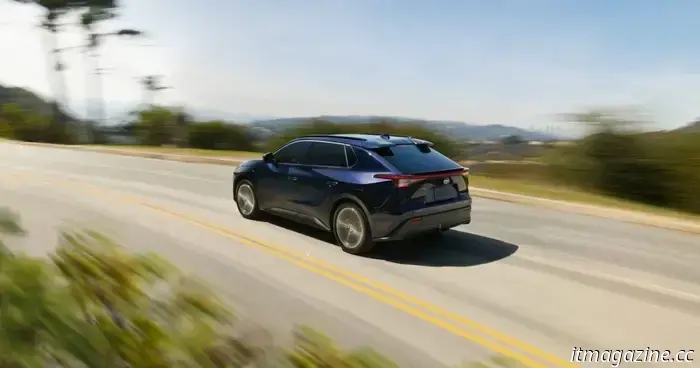
Toyota reveals the 2026 bZ: An advanced electric SUV with an extended range.
Toyota bZ/Toyota USA
Toyota has re-entered the electric SUV segment with the 2026 bZ, a significant update of its bZ4X that meets two major requests from EV users: extended range and quicker charging times.
The prominent highlight is the enhanced driving range. Toyota now predicts a maximum of 314 miles on a single charge for the front-wheel-drive version equipped with the larger 74.7-kWh battery—approximately 60 miles more than the previous bZ4X model. The all-wheel-drive versions also see an improvement, offering up to 288 miles of range depending on the specific trim.
While the charging speeds remain unchanged in terms of maximum kilowatts (still limited to 150 kW for DC fast charging), Toyota has made significant strides in how long peak charging speeds can be maintained. When preconditioning is activated—particularly beneficial in colder temperatures—the new bZ can charge from 10% to 80% in about 30 minutes. Other updates include Plug and Charge functionality for automatic payments at compatible stations and full integration of the North American Charging Standard (NACS), which ensures access to Tesla Superchargers will be available by 2026.
Beneath the vehicle, Toyota has incorporated higher-performance silicon carbide components to enhance efficiency and power delivery. The AWD model now generates up to 338 horsepower and accelerates from 0 to 60 mph in a speedy 4.9 seconds.
Toyota has also revamped the exterior, replacing the black cladding with body-colored wheel arches and giving the front fascia a sleeker design. Inside, a new larger 14-inch touchscreen now controls climate functions, creating a more polished and less crowded dashboard. Additionally, there’s improved storage with a redesigned center console.
With the 2026 bZ, Toyota appears to be addressing criticisms of the bZ4X. It’s quicker, more efficient, and improved for drivers—marking a significant advancement in Toyota's EV efforts.
Nick Godt has reported on global business news across three continents for over 25 years.
I drove 500 miles with Android Automotive: Here’s why every car should have it
The realms of smartphones and automobiles have been increasingly merging, as Google and Apple have focused on enhancing experiences through CarPlay and Android Auto, respectively, while automakers have continued to develop their own infotainment systems.
Despite the popularity of Apple CarPlay and Android Auto, both platforms face critical limitations, primarily because they operate on top of the car's operating system. This results in a lack of seamless integration, which is essential for an optimal experience, and necessitates the use of a smartphone for certain features. To remedy these issues, both companies are concurrently working on operating systems designed to run directly in vehicles.
Uber teams up with May Mobility to introduce thousands of autonomous vehicles to U.S. streets
The pursuit of self-driving technology is accelerating, and Uber is enhancing its capabilities. In a new multi-year collaboration, Uber and autonomous vehicle (AV) developer May Mobility will start offering driverless rides in Arlington, Texas by the end of 2025, with plans for thousands more vehicles across the U.S. in the coming years.
Uber has made significant progress toward making autonomous ride-hailing a commonplace service. The company already partners with Waymo, which operates its robotaxis in several cities, and is now integrating May Mobility’s hybrid-electric Toyota Sienna vans into its platform. Initially, these vehicles will include safety drivers but are expected to operate fully autonomously as deployment progresses.
May Mobility has experience in this field. Supported by Toyota, BMW, and other major players, it has provided AV services in designated areas since 2021. Its AI-based Multi-Policy Decision Making (MPDM) technology enables quick and safe responses to unpredictable real-world situations—helping establish trust in partnerships with cities throughout the U.S. and Japan.
This move into ride-hailing aligns with a wider industry trend. Waymo, regarded as a leader in AV technology, is expanding its services in cities like Phoenix and Austin. Meanwhile, Tesla is getting ready to launch its first robotaxis in Austin this June, featuring a small fleet of Model Ys powered by its camera-based Full Self-Driving (FSD) system. While Tesla seeks affordability and scalability, Waymo and May prioritize safety-oriented deployments using sensor-rich technologies, including lidar—a technology favored by regulators thus far.
Beyond ride-hailing, the concept of privately owned self-driving cars is also gaining popularity. Waymo and Toyota recently announced they are investigating ways to implement full autonomy in personal vehicles, which could eventually bring robotaxi technology into individual garages.
With major names like Uber, Tesla, Waymo, and now May Mobility involved, the ride-hailing landscape is changing rapidly, making the future increasingly focused on vehicles that do not require a driver.
The Ioniq 5 is once again eligible for the $7,500 tax credit





Other articles
 OpenAI has made its most advanced coding model accessible to paid users of ChatGPT.
OpenAI's newest AI model, GPT-4.1, is now available to ChatGPT Plus, Pro, and Team users, expanding its improved coding abilities and speed to a broader audience.
OpenAI has made its most advanced coding model accessible to paid users of ChatGPT.
OpenAI's newest AI model, GPT-4.1, is now available to ChatGPT Plus, Pro, and Team users, expanding its improved coding abilities and speed to a broader audience.
 Three PBS programs to check out in May 2025.
This month, our selections for PBS programs to watch feature a period drama based on Jane Austen, along with two episodes of Great Performances.
Three PBS programs to check out in May 2025.
This month, our selections for PBS programs to watch feature a period drama based on Jane Austen, along with two episodes of Great Performances.
 Sony discounts: This week, the 75-inch Bravia 3 LED TV has a price reduction of $100.
The Sony Bravia 8 Series 4K LED is available this week for just $800, which is a $100 reduction from its regular price. You can take advantage of this offer at Amazon, Best Buy, and Walmart.
Sony discounts: This week, the 75-inch Bravia 3 LED TV has a price reduction of $100.
The Sony Bravia 8 Series 4K LED is available this week for just $800, which is a $100 reduction from its regular price. You can take advantage of this offer at Amazon, Best Buy, and Walmart.
 This Android update may prevent your phone from being stolen.
This Android update may prevent your phone from being stolen.
This Android update may prevent your phone from being stolen.
This Android update may prevent your phone from being stolen.
 The Gigabyte GeForce RTX 5080 GPU is discounted by $100, but there is a caveat.
The Gigabyte GeForce RTX 5080 graphics card is available at Newegg with a $100 price reduction, bringing the cost down to $1,260, but there is a condition.
The Gigabyte GeForce RTX 5080 GPU is discounted by $100, but there is a caveat.
The Gigabyte GeForce RTX 5080 graphics card is available at Newegg with a $100 price reduction, bringing the cost down to $1,260, but there is a condition.
 3 excellent BritBox series to check out in May 2025
BritBox is a streaming platform that boasts an impressively extensive collection of excellent British television series. Check out the shows available to watch this May.
3 excellent BritBox series to check out in May 2025
BritBox is a streaming platform that boasts an impressively extensive collection of excellent British television series. Check out the shows available to watch this May.
Toyota reveals the 2026 bZ: An advanced electric SUV with an extended range.
Toyota's bZ electric SUV offers significant improvements in both range and charging capabilities.
